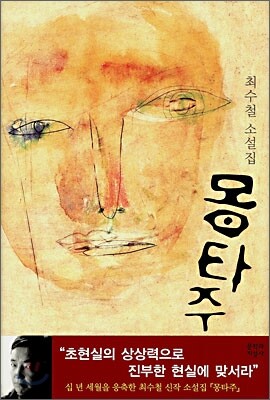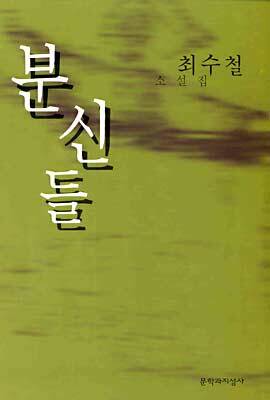Choi Suchol (born 1958) is a South Korean novelist and professor.
Life
Choi Suchol was born in Chuncheon, Gangwon Province. He received his undergraduate and graduate degrees in French literature from Seoul National University. His doctoral dissertation was on the writings of Michel Butor. Choi debuted in 1981 by winning the Chosun Ilbo New Writer's Contest with his story "Maengjeom" (맹점 Blind Spot). A prolific writer, Choi has published over 20 volumes of fiction over the course of his career, including Gongjung nugak (공중누각 Castle in the Air), Goraeui baetsogeseo (고래의 뱃속에서 In the Wale's Belly), Modeun sinpodo miteneun yeouga itda (모든 신포도 밑에는 여우가 있다 There is a Fox under Every Bunch of Sour Grapes), Eoneu mujeongbujuuijaui sarang (어느 무정부주의자의 사랑 Love of an Anarchist), and Dogui kkot (독의 꽃 Poisonous Flower). Choi has received the Yi Sang Literary Award, the Kim Yu-jeong Literary Award, and the Dong-in Literary Award. He is currently professor of creative writing at Hanshin University.
Writing
The point of departure for Choi Suchol's fiction is the claim that genuine communication has become impossible in the print culture of the modern age, and he is known for the abstruse quality of his works. Without resorting to traditional structure or characterization, Choi delves into the liminal area between the conscious and the subconscious, often placing as much emphasis on language and the style of writing as the content itself.
This claim forms the basis of his early work, "Gongjung nugak," which features a protagonist who desires to but cannot communicate with the world. "Sorie daehan myeongsang" (소리에 대한 명상 A Meditation on Sounds) and "Siseon go" (시선고 A Consideration of the Eyes) resurrect systems of meaning inscribed onto the physical body itself as possible alternatives to the written language. The search for a means of communication that predates actual language continues in "Hwadu, girok, hwaseok" (화두, 기록, 화석 Hwadu, Record, Fossil), Byeokhwa geurineun namja (벽화 그리는 남자 The Mural Painter) and "Eoreumui dogani" (얼음의 도가니 Crucible of Ice).
Choi Suchol's method is often clinical; he dissects or lengthens observed phenomena and reconstructs them in a way that deliberately flouts the principle of recognizability. His search for alternative means of communication is predicated on the desire to achieve sympathetic understanding with other beings, a desire he views as being frustrated in the modern world of overdetermined signs.
Le point de départ des romans de Choi Su-cheol est l'affirmation selon laquelle une véritable communication devient impossible dans la culture de l'imprimerie à l'âge moderne. Il est connu pour la qualité absconse de ses œuvres3. Cette affirmation est à la base de ses premiers travaux, notamment dans Une tour dans l'air (Gongjung nugak), qui met en scène un protagoniste qui ne peut pas communiquer avec le monde. Une méditation sur les sons (Sorie daehan myeongsang), Sur le regard (Siseon go), et Histoires secrètes sur le corps (Mome daehan eunmilhan iyagideul) ressuscitent les systèmes de signification inscrits sur le corps physique en lui-même comme une alternative possible à la langue écrite. La recherche d'un moyen de communication qui soit antérieur au langage continue dans Propos, enregistrement, fossile (Hwadu, girok, hwaseok), Amour d'un anarchiste (Eoneu mujeongbuju-uija-ui sarang), L'homme qui fait de la peinture murale (Byeokhwa geurineun namja) et Le creuset de glace (Eoreumui dogani, 1993). La méthode d'écriture de Choi Suchol est souvent « clinique » ; il dissèque les phénomènes observés et les reconstruit d'une manière qui bafoue délibérément les lois de la logique. Sa recherche de moyens alternatifs de communication est fondée sur le désir de parvenir à une compréhension saine avec autrui, un désir qu'il considère comme étant frustré dans un monde moderne où les signes sont surdéterminés.
최수철(1958~)은 대한민국의 소설가다.
생애
최수철은 1958년 강원도 춘천에서 태어났다. 1977년 춘천고등학교를 졸업하였으며, 1981년 서울대학교 인문대학 불문과, 1984년 동대학원 불문과를 졸업하였다. 1990년부터 1991년까지 프랑스 파리대학교에서 수학하였으며, 1995년 미셸 뷔토르 연구로 박사학위를 받았다.
최수철은 1981년 《조선일보》 신춘문예에 <맹점>이 당선되며 작품 활동을 시작했다. 1981년 단편소설 〈신유년 겨울, 혹은 계륵〉과 〈사소한 부재를 위하여〉, 1982년 《우리세대의 문학》에 단편 〈타임 킬링〉을 잇달아 발표하는 등 활발한 작품 활동을 했으며, 다수의 작품집을 출간했다. 1993년 《얼음의 도가니》로 제17회 이상문학상을 수상했고, 그 외 김유정문학상(2009년), 과 동인문학상(2019)등 다수의 문학상을 받았다.
한편 작가는 창작소설을 발표하면서 프랑스 문학을 번역하는 작업도 지속적으로 병행하고 있다. 한신대학교 문예창작학과 교수로 일하고 있다.
작품 세계
최수철은 관념적인 사유를 바탕으로 정밀한 문장과 다양한 주제로 소설의 형식을 실험한다. 작가는 일상적인 삶의 의미, 인간의 허위의식, 성(性)에 대한 억압 등 사람들 사이의 다양한 관계에서 발생하는 의미와 그 속에서 얻은 반성적 사유를 소설로 형상화하고 있다.
중편소설집 《화두, 기록, 화석》(1987)에서 작가는 개인 사이의 소통의 문제에 천착하여, 개인들을 연결해주는 언어를 탐구하고 소설화했다.
소설집 《갓길에서의 짧은 잠》(2012)에서 작가는 전작(前作)들에서 보여주었던 인간에 대한 회의와 갈등에 관한 문제의식을 지속하면서 빠른 전개로 이야기를 구성했다.
장편 《독의 꽃》(2019)은 몸속에 독을 지니고 태어난 인물이 독을 점점 키우다가 죽음에 이르는 이야기로, 작가는 세상에 존재하는 모든 독과 약을 소설의 주제로 삼았다. 작가는 심리학, 상징주의, 임상 기록과 추리 기법 등 다양한 소설 형식을 통해 독과 약에 지배된 인간의 삶에 질문을 던진다.
소설집 《사랑의 다섯 가지 알레고리》(2021)는 일관된 주제를 바탕으로 구성된 연작소설집이다. 작가는 인간 본질과 시대에 대한 탐구의 과정을 ‘사랑’이라는 주제로 담아내었다. 작가는 의자, 가면, 모래시계, 욕조, 매미라는 다섯 개의 사물들을 긴밀히 연결시키고, 신화와 고전, 심리학적 이론 등을 동원해 인간의 사랑이 지니는 유한성(有限性)과 고독, 그리고 헛된 열정과 기다림, 상처 등을 이야기로 풀어내었다.
주요 작품
1) 소설집
《화두, 기록, 화석》, 문학과지성사, 1987
《배경과 윤곽》, 고려원, 1987.
《말(馬)처럼 뛰는 말(言)》, 고려원, 1990.
《알몸과 육성》, 열음사, 1991.
《무정부주의자의 사랑》, 열음사, 1991.
《몸에 대한 은밀한 이야기들》, 문학사상사, 1994.
《내 정신의 그믐》, 문학과지성사, 1995.
《분신들》, 문학과지성사, 1998.
《공중누각》, 문학과지성사, 1986.
《매미》, 문학과지성사, 2000.
《모든 신포도 밑에는 여우가 있다》, 샘터사, 2001
《몽타주》, 문학과지성사, 2007.
《갓길에서의 짧은 잠》, 문학과지성사, 2012.
《포로들의 춤》, 문학과지성사, 2016.
《사랑의 다섯 가지 알레고리》, 문학과지성사, 2021.
2) 장편소설
《어느 무정부주의자의 사랑》, 열음사, 1989
《고래 뱃속에서》, 문학사상사, 1989.
《즐거운 지옥의 나날》, 열음사, 1990.
《벽화 그리는 남자》, 민음사, 1992.
《불멸과 소멸》, 범우사, 1995.
《페스트》, 문학과지성사, 2005.
《침대》, 문학과지성사, 2011.
《사랑은 게으름을 경멸한다》, 현대문학, 2014.
《독의 꽃》, 작가정신, 2019.
수상 내역
1988년 제4회 윤동주문학상
1993년 제17회 이상문학상
2009년 제3회 김유정문학상
2019년 제50회 동인문학상





